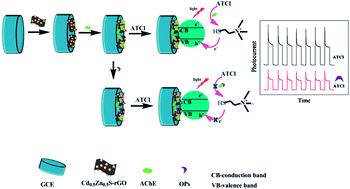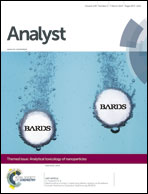A visible light photoelectrochemical biosensor coupling enzyme-inhibition for organophosphates monitoring based on a dual-functional Cd0.5Zn0.5S-reduced graphene oxide nanocomposite
Abstract
A novel visible light photoelectrochemical (PEC) platform coupled with enzyme-inhibition for rapid and sensitive determination of organophosphates (OPs) was constructed based on a dual-functional Cd0.5Zn0.5S-reduced graphene oxide (Cd0.5Zn0.5S-rGO) nanocomposite. Due to the inherent biocompatibility of the Cd0.5Zn0.5S-rGO nanocomposite, acetylcholinesterase (AChE) immobilized on the Cd0.5Zn0.5S-rGO modified electrode can hydrolyze acetylthiocholine chloride into thiocholine, which could increase the photocurrent of the enzyme electrode, and the further inhibition of OPs on the enzyme electrode could decrease the photocurrent response. Based on the notable change in the PEC response of the AChE–Cd0.5Zn0.5S-rGO modified electrode and using Dursban as a model, a simple and effective way for PEC monitoring of OPs is proposed, which showed a wide linear range of 0.001–1 μg mL−1 with a low detection limit of 0.3 ng mL−1 (S/N = 3). Moreover, the biosensor was successfully challenged with water samples, demonstrating a new method for rapid and sensitive screening/evaluating exposure to organophosphorus pesticides and other hazardous substances.


 Please wait while we load your content...
Please wait while we load your content...